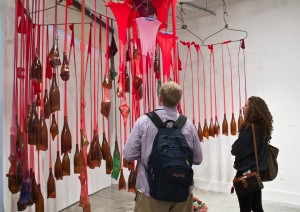The Far East met the East Coast at the “Inter-Mediate: Selected Contemporary Chinese American Art” show, which opened in the College Art Gallery on Wednesday, Oct. 25. The exhibit features the work of eight artists, all of whom have immigrated to the U.S. from China.
Before the official opening of the gallery, artists Hu Bing, Cui Fei, Sin-ying Ho, Song Xin, LiQin Tan, Zhang Hongtu, O Zhang and Zheng Lianjie sat down for a round-table discussion, where they briefly went over some of the inspiration behind their featured works. Jiayan Mi, associate professor of comparative literature, English and world languages and cultures, introduced the artists as “CIAs”: Chinese Immigrant Artists. He also continually referred the group as the “eight Immortals,” echoing a popular Chinese legend about a group with the tools to give life and destroy evil.

Among the works displayed were O Zhang’s photographs, including three photos from her 21-part series “Horizon” and “Always Be Ready” from “The World is Yours (But Also Ours).” The “Horizon” photographs feature images of young girls growing up in Zhang’s childhood village in Western Hunan province. Despite an aura of deep sadness around the girls, there’s a look of hard determination in their eyes, as though they haven’t given up hope quite yet.
These pictures have a distinct air of feminism about them, which is no surprise as the artist seems to be something of a feminist.
“I’m very concerned about gender issues in China,” Zhang said when introducing “Horizon.”
Before turning to photography, Zhang studied to be a painter, but found her teachers too strict for her liking. “I had enough of all the pressure from authority,” she explained.
Ho’s contribution to the show is a series of ceramic sculptures. Titled “Made in the Postmodern Era,” “Walmart, KFC,” “Seeing Eve,” and the largest of the bunch, “In a Dream of Hope No. 1,” her work combines more-traditional Chinese images with those of Barbie, Colonel Sanders and even the Dow Jones Index. According to a pamphlet given out during the round-table discussion, Ho’s sculptures “intend to subvert a monolingual, homogeneous cultural identity.”
Although paper cutting is an ancient Chinese folk art, Xin stumbled upon it by accident. She told the audience that she had just been cutting up magazines before her friend told her that what she was doing was an actual artistic technique.
Her pieces become more complex the longer they are looked at, with what initially looks to be flowers and leaves giving way to reveal magazine pictures of old men and boxes of peaches. One of her pieces, “Here and Now,” is comprised entirely of clippings from pornographic magazines yet comes together to form a beautiful image.
The gallery will be open through Dec. 11.






